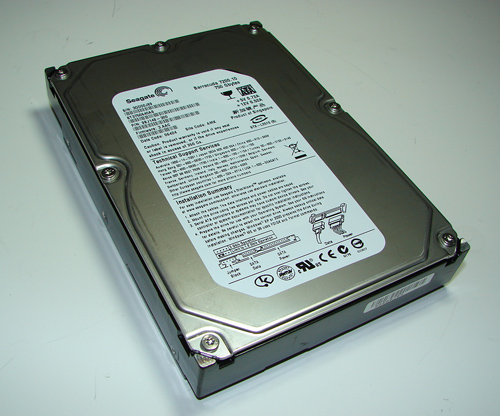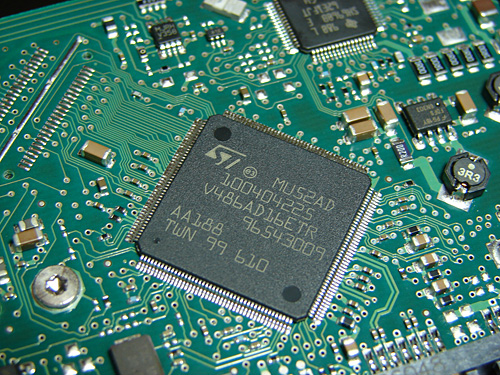Seagate Barracuda 7200.10 750GB: Size Does Matter
by Gary Key on May 18, 2006 9:00 AM EST- Posted in
- Storage
Feature Set and Options

The external casing design of the Seagate Barracuda 7200.10 series is basically unchanged from the previous generation 7200.9 series. The drive is based on the industry standard 3.5" form factor platform with pertinent part number and warranty information embossed on a white sticker on the top of the casing. However boring the exterior design maybe, lurking under the plain casing is an impressive 750 GB storage capacity that did not require a new form factor or additional platters. Based upon the potential of perpendicular technology, this same casing could be holding two terabytes of capacity in a relatively short time.

The 7200.10 SATA family ships with the Serial ATA data and power connectors only. There is no longer support for the 4-pin Molex power connector designed for use with older ATX power supplies. To the left of the data and power connectors is a four pin jumper block. This jumper block will determine whether the drive operates in Serial ATA/150 or Serial ATAII/300 mode. Two pins are enabled by default, meaning the Seagate Barracuda 7200.10 ships and will operate in SATA/150 mode. In order for the drive to operate in Serial ATAII/300 mode, the jumper must be removed. Enabling SATAII/300 is recommended if you have a compatible motherboard that fully supports SATA II/300 operations. While this feature was advantageous for burst transfer rates in our synthetic benchmarks, overall we did not see any real improvement in our real world benchmarks.

The PCB is openly visible on the bottom of the drive as in previous series and now contains an ST Micro controller chip. The ST Micro Serial ATA controller chipset is a departure for Seagate as they have previously used an Agere chipset. Our recently delivered Seagate 7200.9 500GB test unit is also employing the ST Micro chipset, so it appears this is a change for both drive series at this time. The 16 MB of cache memory is located on the opposite side of the PCB.
 |
| Click to enlarge |
Seagate currently has 14 variations of the 7200.10 product series planned for release over the next few weeks, with select drives also being offered in the external Pushbutton Back-up Hard Drive line in late May or early June. The entire lineup features perpendicular recording technology with our review unit being the new high capacity model at 750GB. This is the industry's highest offered capacity in a single disk drive and is made possible by four 188GB platters spinning at 7200 RPM with a 16-megabyte buffer size.
Seagate is also introducing two new technologies in the 7200.10 products. The first is Adaptive Fly Height, and it maximizes the consistency of read/write performance across the entire disc by adjusting the fly height (distance between the disc head and platter) according to changes in environmental operating conditions. The second is Clean Sweep that assists in maintaining media integrity and drive reliability by passing the drive head over the entire platter during power-on to smooth out any irregularities in the disc surface.
Capacities for the 7200.10 series range from 200GB to 750GB with PATA, SATA 1.5Gb/s, and SATA 3.0Gb/s interfaces being offered. The 200GB and base 250GB models feature an 8MB buffer while the 250GB, 320GB, 400GB, 500GB, and 750GB models will have 16MB buffers. Seagate has dropped the MTBF (mean time between failures) measurement and switched to a percentage based Annualized Failure Rate (AFR) measurement which is estimated to be 0.34%.
A complete price list has not been published; however, Seagate says the 200GB model will retail at US $105 with the 750GB model currently offered for around US $500. Product launch has already occurred with the 750GB being widely available at online retailers, and the balance of the product line is expected within the next couple of weeks and at the brick and mortar outlets in late June.










44 Comments
View All Comments
Gary Key - Thursday, May 18, 2006 - link
The charts have been changed. :)
VooDooAddict - Thursday, May 18, 2006 - link
I like the "db(A)@5mm" sugestion.FallenDeathAngel - Thursday, May 18, 2006 - link
The RaptorWD1500ADFD Western Digital
Raptor
WD5000YS
Yes....
SpaceRanger - Thursday, May 18, 2006 - link
That the only drive you tested in RAID-0, was the new Seagate drive. The performace charts are kinda useless when the RAID-0 scores are included, cause it misleadingly shows the Seagate drive on top of a good portion of them. Without examples of RAID-0 performance from the WD1500 Raptor, or the WD5000YS, you are giving the impression of favoritism towards the Seagate drive.Gary Key - Thursday, May 18, 2006 - link
Good Day....from page 5-
We are providing RAID 0 results for the Seagate 7200.10 for comparative results to the single drive. Seagate has recently released updated firmware for the 500GB 7200.9 that improves RAID performance; unfortunately we were unable to complete our testing with the new firmware before publication. Our RAID results for the WD1500 series will be published in our next storage article.
We will have RAID O results for both of these drives in the 500GB roundup. We are not tyring to show favoritism towards the Seagate drive. Our comments are quite clear about the effects of RAID 0 in the I/O operations that while interesting, they do not always translate to actual 1:1 improvements in application usage. Our application timing tests bear this out to some degree.
We debated on showing the Seagate RAID 0 results as it is a no win situation. I am sure based upon the comments from our last couple of reviews that about as many people would be asking why we did not provide RAID 0 results. We are currently completing the RAID 0 results with the WD1500 drives, we ran into a couple of issues that required technical conversations with WD. Also, the sheer scope of testing every drive in RAID configurations is extremely time consuming with results that are basically the same when compared to the single drive scores.
My personal opinion is that RAID 0 is only effective in such a limited scope of applications that we should not report it at all. However, this feature has been pushed by the core logic chipset suppliers, marketed by the motherboard suppliers, and eventually becomes a test request by the user community. I would much rather show the benefits of RAID 5, 0+1, 10 in a separate article, which we will in the future. It is difficult at times to procure three samples of each drive. ;-)
I appreciate your comments, they will probably not be the last on this subject.
srk052004 - Thursday, May 25, 2006 - link
Hi Gary (and all). I have been told that for my purposes (manipulating 40gb SAS or SPSS data sets), RAID 0 really would be appropriate. Do you agree? Or, would you say that RAID 10 would still be preferable?I, too, would LOVE to see results comparing different capacities of 7200.10.
BTW, this was an interesting review.
SpaceRanger - Thursday, May 18, 2006 - link
Thank you for the quick response :)If you wants to show the comparision between RAID-0 and the Single drive, then have seperate charts showing just those 2. It makes the analysis of the performance much easier.
Now THAT'S an article I'd love to read as well!
Zoomer - Friday, May 26, 2006 - link
Ditto. It would be a nice way to split up articles into _more_ managable chunks of work!Thanks for the review! Will be looking forward to the ibm (hitachi), seagate and WD shootout.
Gary Key - Saturday, June 24, 2006 - link
We will change our format in July with the 500GB and 250~320GB roundups. I too would like to manage the chunks of work in different fashion.Questar - Thursday, May 18, 2006 - link
Then what was different than what Seagate claimed?